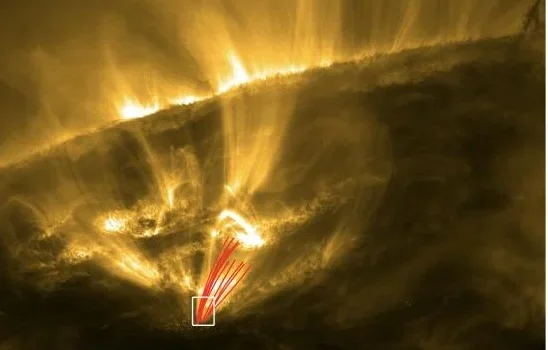A team of astronomers from several European institutions, led by Northumbria University in Newcastle, has discovered “shooting stars” in the Sun. European Space Agency’s Solar Orbiter (SolO) observations have revealed never-before-seen meteor-like fireballs appearing in spectacular plasma displays known as “shooting stars” or coronal showers. The study will be presented at the National Astronomy Meeting (NAM 2023) this week by lead author Patrick Antolin, an associate professor at Northumbria University.
While coronal rain is not real water, it is a condensation process in which some of the Sun’s fiery matter is clump together due to sudden local temperature changes. The corona, the outermost part of the sun’s atmosphere, is made up of gas at millions of degrees Celsius, and rapid temperature drops create clumps of ultra-dense plasma up to 250 kilometers wide. These fireballs plummet toward the Sun as gravity pulls them at more than 100 kilometers per second.
The work will be published in a special issue. Astronomy and Astrophysics, is dedicated to SolO’s first perihelion point near the Sun. Currently available on prepress server arxiv.
In the spring of 2022, SolO passed very close to the Sun, with a distance of just 49 million kilometers – one-third the distance between Earth and the Sun – providing the best spatial resolution of the Solar corona.
Alongside the first super-resolution images of coronal raindrops, SolO observed the heating and compression of gas directly beneath them. The burst of density that emerged under the clusters shows that the gas warmed to a million degrees and took a few minutes to fall.
On Earth, “shooting stars” are formed when meteoroids or objects in space ranging in size from dust particles to small asteroids enter our atmosphere at high velocities and burn. Only some meteorites reach the ground without breaking up, and those that break apart can form large craters.
But the Sun’s corona is thin and low-density and doesn’t remove much material from the clusters, so scientists believe most shooting stars reach the Sun’s surface intact. Its effects have never been observed, and SolO observations have shown that this process can result in short-lived, strong illumination as the material explodes upward and shock waves reheat the gas.
“shooting stars” and meteorites in Earth’s atmosphere are characterized by the awakening of a meteor’s orbit, which occurs when heated material beneath it ruptures parts of the object, a process called ablation. The same thing happens with comets orbiting the Sun. However, ablation does not occur in the solar corona because of its magnetic field. Instead, the incoming gas is partially ionized and follows magnetic field lines that act like giant pipes to guide the gas. Compression and heat from below prevent clots from forming tails, making this phenomenon much more difficult to catch in the sun.
Patrick Antolin, lead author of the project, says: “The inner solar corona is so hot that we will never be able to study it in situ with a spacecraft. However, SolO orbits close enough to the Sun to detect minor events occurring inside the corona, such as the effects of rain on the corona. This allows us to obtain a valuable indirect investigation of the coronal medium, which is crucial for understanding its composition and thermodynamics. Like how the sun warms to millions of degrees.”
“If humans were extraterrestrials that could live on the surface of the sun, we’d be constantly enjoying the magnificent view of shooting stars,” Antolin jokes, “but we’d have to watch our heads.”
These SolO observations also confirmed previous work showing that coronal rain is much more common than previously thought.














